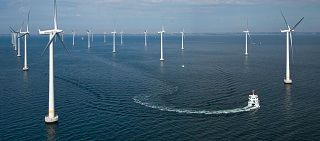The Future of Off-shore Wind

Here, technologies are less mature and costs are higher, but they are declining faster due to being at an earlier stage in the learning curve.
The optimum size here appears to be over 6 MW; MHI Vestas has commercialized an 8 MW turbine with a 164 meter sweep. Few people realize how big this is; the swept area of this turbine is equal to three soccer fields.
Future turbines are expected to get even larger as foundations, cable connections, and O&M all form a far larger component of levelized cost of electricity than onshore; larger turbines mean fewer foundations, fewer cable connections, and fewer units to maintain.
This being the case, a larger turbine, even if its cost per kW is higher, can be cost-effective if the extra turbine costs are offset by greater savings elsewhere in the overall wind farm package. Foundations, cabling, and O&M only increase slightly with larger offshore turbine size, so the industry demands ever larger turbines. Thus, higher towers, larger generators and longer blades become an attractive means to lower levelized cost of electricity.
Prototype wind turbines rated at 10 MW are at an advanced stage of design, and likely to begin deployment shortly, while even larger turbines up to 20 MW are at the early research concept stage. It remains to be seen how big offshore turbines will eventually get but it is a fair assumption that those over 10 MW will eventually become the norm for this market segment.
Within the offshore wind industry, there is an emerging subsection of floating wind turbines. With fixed offshore wind turbines, there is a limit to viable water depth which limits suitable sites to areas with water depth up to around 30 meters. Floating designs allow deeper waters to be exploited, greatly increasing the number of potential sites for offshore wind power, and allowing the turbines to be placed further out to sea in areas with better wind resources.
With further R&D and volume production, it is likely that floating wind farms can match, or possibly even better the costs of fixed offshore wind power.
